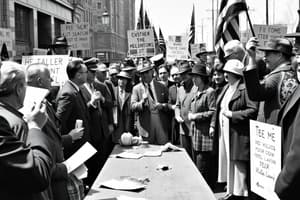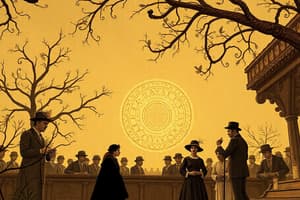Podcast
Questions and Answers
What was a primary aim of The Progressive movement?
What was a primary aim of The Progressive movement?
- To promote laissez-faire economic practices
- To establish a socialistic state
- To completely abolish capitalism
- To regulate and improve society through government power (correct)
Which group primarily comprised the reformers in the Progressive movement?
Which group primarily comprised the reformers in the Progressive movement?
- Radical socialists and anarchists
- Wealthy industrialists
- Working-class immigrants
- Middle-class men and women, predominantly women (correct)
What was the function of muckrakers during The Progressive movement?
What was the function of muckrakers during The Progressive movement?
- To create a unified movement among progressives
- To expose societal problems through sensationalist journalism (correct)
- To advocate exclusively for workers' rights
- To promote laissez-faire economic policies
Why were muckrakers named so by Theodore Roosevelt?
Why were muckrakers named so by Theodore Roosevelt?
What common approach did most progressives share?
What common approach did most progressives share?
Which of the following best describes the nature of The Progressive movement?
Which of the following best describes the nature of The Progressive movement?
Ida Tarbell is best known for her work on which subject?
Ida Tarbell is best known for her work on which subject?
What was the primary focus of Lincoln Steffens's work "The Shame of the Cities"?
What was the primary focus of Lincoln Steffens's work "The Shame of the Cities"?
Which Supreme Court case upheld laws protecting women workers and restricted their working hours?
Which Supreme Court case upheld laws protecting women workers and restricted their working hours?
What was one goal of the National Child Labor Committee?
What was one goal of the National Child Labor Committee?
Which reform was introduced to allow voters to directly vote on local laws?
Which reform was introduced to allow voters to directly vote on local laws?
What was the significance of the Triangle Shirtwaist Fire in labor relations?
What was the significance of the Triangle Shirtwaist Fire in labor relations?
Who was a leader of the National Consumers’ League advocating for labor rights?
Who was a leader of the National Consumers’ League advocating for labor rights?
What essential part of the Wisconsin Idea aimed at regulating?
What essential part of the Wisconsin Idea aimed at regulating?
What differentiates the 'Wet' and 'Dry' factions in the temperance movement?
What differentiates the 'Wet' and 'Dry' factions in the temperance movement?
What reform allowed voters to remove elected politicians from office before their term expired?
What reform allowed voters to remove elected politicians from office before their term expired?
Which of the following cities was home to the first settlement house, Hull House?
Which of the following cities was home to the first settlement house, Hull House?
Which of the following was a key difference between Theodore Roosevelt's approach to regulating corporations compared to his predecessors?
Which of the following was a key difference between Theodore Roosevelt's approach to regulating corporations compared to his predecessors?
Which of the following statements accurately reflects the impact of Upton Sinclair's 'The Jungle' on the Progressive movement?
Which of the following statements accurately reflects the impact of Upton Sinclair's 'The Jungle' on the Progressive movement?
How did Theodore Roosevelt's approach to conservation differ from the approach of preservationists?
How did Theodore Roosevelt's approach to conservation differ from the approach of preservationists?
Which of the following acts directly increased the power of the Interstate Commerce Commission (ICC)?
Which of the following acts directly increased the power of the Interstate Commerce Commission (ICC)?
Which of the following statements accurately reflects the role of the Woman’s Christian Temperance Union in the Progressive Era?
Which of the following statements accurately reflects the role of the Woman’s Christian Temperance Union in the Progressive Era?
Flashcards
Square Deal
Square Deal
The series of Progressive reforms proposed by Theodore Roosevelt focused on corporations, consumers, and conservation.
Trust-Busting
Trust-Busting
The practice of breaking up monopolies and trusts to promote competition, exemplified by Roosevelt's efforts.
Meat Inspection Act (1906)
Meat Inspection Act (1906)
Legislation that mandated federal regulation and inspection of the meat industry to ensure sanitary conditions.
Pure Food & Drug Act (1906)
Pure Food & Drug Act (1906)
Signup and view all the flashcards
Conservation vs Preservation
Conservation vs Preservation
Signup and view all the flashcards
The Progressive Movement
The Progressive Movement
Signup and view all the flashcards
Reason for Progressive Movement
Reason for Progressive Movement
Signup and view all the flashcards
Nature of Progressives
Nature of Progressives
Signup and view all the flashcards
Muckrakers
Muckrakers
Signup and view all the flashcards
Ida Tarbell
Ida Tarbell
Signup and view all the flashcards
Diverse reformers
Diverse reformers
Signup and view all the flashcards
Women's Suffrage
Women's Suffrage
Signup and view all the flashcards
Jacob Riis
Jacob Riis
Signup and view all the flashcards
Lincoln Steffens
Lincoln Steffens
Signup and view all the flashcards
Women's Role in Progressivism
Women's Role in Progressivism
Signup and view all the flashcards
Muller vs Oregon
Muller vs Oregon
Signup and view all the flashcards
Triangle Shirtwaist Fire
Triangle Shirtwaist Fire
Signup and view all the flashcards
Wisconsin Idea
Wisconsin Idea
Signup and view all the flashcards
Direct Primary
Direct Primary
Signup and view all the flashcards
17th Amendment
17th Amendment
Signup and view all the flashcards
Temperance Movement
Temperance Movement
Signup and view all the flashcards
National Child Labor Committee
National Child Labor Committee
Signup and view all the flashcards
Study Notes
The Progressive Movement
- Factors contributing to the Progressive Movement: Industrialization, urbanization, and immigration created significant social and economic challenges in the U.S.
- Progressive Movement definition: An attempt to use government power to regulate and improve society.
- Rejection of laissez-faire ideology: Progressive reformers rejected the idea of minimal government intervention in the economy.
- Not a radical movement: Progressives didn't aim to overthrow capitalism, but rather to improve it.
- Diverse group of reformers: The Progressive movement included a variety of reformers, primarily middle-class men and women, not a cohesive group.
- Goals of Progressives: included temperance (reforming alcohol use), regulating monopolies, improving workers' rights, and women's suffrage.
- African Americans also advocated for greater equality.
Promoting Reform Through Muckrakers
- Muckrakers: investigative journalists who exposed societal problems and spurred public action.
- Sensationalized stories: Their writing often included shocking details to grab the public's attention.
- Examples of Muckrakers and their work:
- Ida Tarbell: exposing Standard Oil.
- Jacob Riis: documenting poverty and poor living conditions in the slums of New York.
- Lincoln Steffens: exposing corruption in city politics.
Role of Women in the Progressive Movement
- Women's vital role: Women played a crucial part in advocating for reforms.
- Challenging "separate spheres": Their involvement challenged traditional gender roles.
- Examples of women's activism:
- National Child Labor Committee: advocating against child labor.
- National Consumers' League: advocating for rights of women in the workplace.
- Florence Kelley's work: focusing on child labor and workplace laws.
- Muller v. Oregon: Supreme Court case that upheld laws limiting working hours for women.
Urban Reform
- Significant urban issues: Cities faced problems like poverty, slums, political corruption and substance abuse.
- Examples of urban reform efforts:
- Jane Addams and Florence Kelly: establishing settlement houses (Hull House) to address these issues.
- Municipal reforms: Reforms included placing municipal services under public control and electing heads of city departments to reduce the power of political bosses.
State Reforms
- Progressive Governors: States, especially Wisconsin, were pioneered by progressive reformers like Governor Robert La Follette.
- Wisconsin Idea: initiatives that regulated utilities and implemented tax reforms.
- Examples: regulating utilities, and reforming tax policies.
Political Reforms
- Increased Democracy: Progressive reformers sought to give voters more power.
- Examples of political reforms:
- Australian ballot: Secret voting to prevent coercion
- Direct primaries: Voters nominated candidates.
- Recall and initiative: Reforms allowing voters to remove officials or introduce legislation.
- Referendum: The opportunity to vote directly on laws.
- 17th Amendment: Direct election of Senators by the voters.
Theodore Roosevelt (TR) and the Presidency
- TR's commitment to the Presidency: Strong belief in expanding Presidential power.
- Trust-busting: Aggressive reform measures taken to break up monopolies and bad trusts
- Examples of TR's policies:
- Square Deal: Included reforms on corporations, consumers, and conservation.
- Trust-busting: Breaking up powerful trusts.
- Coal Mine Strike mediation: intervening in strikes when necessary
- Conservation: Champion of natural resource protection.
Corporations: Trust-Busting
- Trust-busting: Breaking up monopolies.
- Sherman Anti-Trust Act: Law ineffective in addressing the power of corporations.
- Roosevelt: differentiating "good" and "bad" trusts, focusing on breaking up the problematic ones.
- Elkins and Hepburn Acts: aimed to regulate railroads.
Consumer Protection
- Sinclair's "The Jungle": Book that exposed unsanitary practices in the meatpacking industry.
Conservation
- Importance of conservation: Recognition of the need to protect natural resources and prevent environmental degradation.
- Key Acts: Sierra Club advocacy, Forest Reserve Act, Newlands Reclamation Act.
Studying That Suits You
Use AI to generate personalized quizzes and flashcards to suit your learning preferences.




